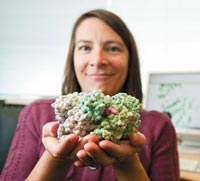Five questions with … Katrina Forest
Bacteriology professor Katrina Forest once considered studying architecture — and in a way she does, albeit on a very small scale. As a protein crystallographer, she studies the three-dimensional structures of bacterial proteins on an atomic level to understand how the proteins function.

Forest
Most of her research focuses on the tiny surface protrusions called pili that bacteria use to move across surfaces and interact with other cells — including both beneficial and harmful interactions — and the molecular motor proteins that drive their movements.
Wisconsin Week: What inspires you in your work?
Forest: Bacteria. I am astonished by microbes and what they’ve figured out how to do. The protein we work on is the strongest biological motor ever described. Bacteria stick to things with incredible tenacity, they produce amazing bio-glues, they have structural proteins that can withstand huge forces, and they know how to speak to each other using small molecule compounds that we still don’t fully appreciate. We’re now trying to solve a lot of the world’s problems using microbes.
WW: Who or what has had the most influence on your work as a scientist?
KF: Sometimes I chose to do things because they were the challenging option, so I think part of the path I followed was “nobody else is doing this” or “this will be more daring.” Admittedly, sometimes it’s miserable — but in the long run it’s stimulating to stretch your brain and keep on stretching.
WW: What about your work do you think surprises people the most?
KF: People are amazed to learn how many processes on Earth are driven by microbes and how much of their own health is dependent on their interactions with microbes. Your immune response is largely governed by what microbes you have already reacted to, and recent research results suggest even psychological imbalances are related to signatures of your microbial flora. We have evolved over many millennia to live with these organisms, so it makes perfect sense that we’re interdependent in countless ways.
The goal of my work is to get at the molecular interactions that ultimately govern these signals.
WW: What outcomes do you see from your work for society?
KF: I think there are potential health benefits of everything we investigate. These pili are what bacteria use to interact with each other, with us, with soil particles, and with catheters in the hospital, so understanding both the good and the bad of those interactions on a molecular level should allow us to either encourage or block them depending on the specific situation.
Another outcome is a better appreciation of the solution microbes have found to the problem of how to build this motor — it’s fascinating. This is basic biology on one hand, but on the other hand, I think there’s the long-term potential for some interesting nanotechnology applications of this motor.
WW: What’s the coolest thing you’ve learned?
KF: The coolest moments are when all our calculations yield a protein structure or when the thermodynamics we study actually explain how the motor works. I love seeing that fundamental chemistry, physics and math lead to astonishing biology.
Tags: faculty
